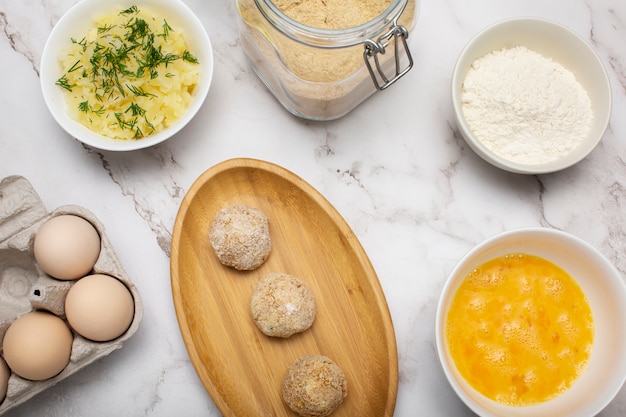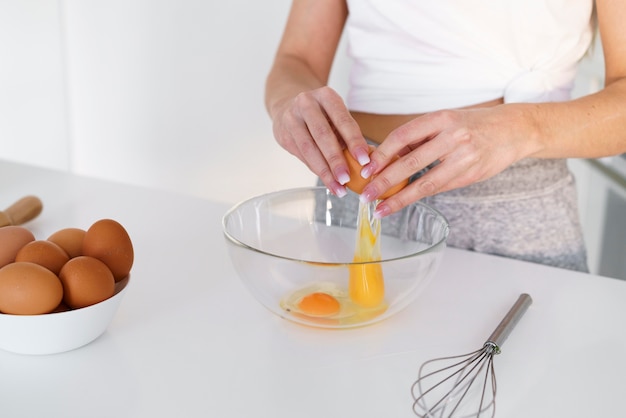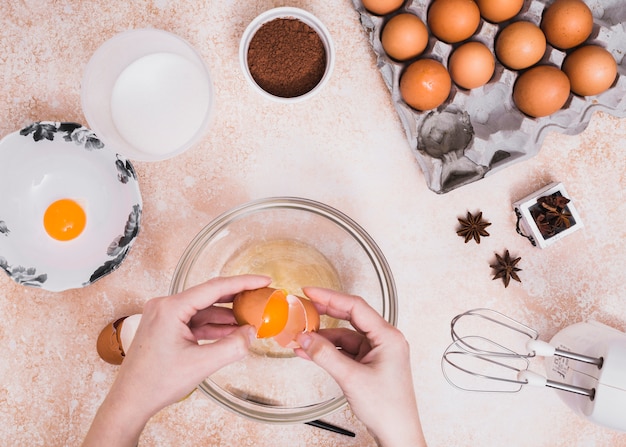Ever felt like you were in a tug-of-war with a boiled egg, trying to pry off that stubborn shell? I've been there, countless times, battling those pesky bits of shell that stubbornly clung to the otherwise perfectly cooked egg. It's enough to make you question the whole point of boiling eggs in the first place, right? But worry no more, my fellow egg enthusiasts! Through countless trials and errors (and a few bruised fingertips), I've learned the secrets to effortless egg peeling, and I'm here to share them all with you.
(Part 1) The Foundation of a Perfect Peel: choosing the right eggs and Boiling Method

The key to easy peeling lies in understanding the basics. It all starts with selecting the right eggs and mastering the perfect boiling method.
Choosing the Right Eggs: Freshness is Key
This is something I've learned the hard way: fresh eggs are your peeling heroes. You see, older eggs, those that have been hanging out in your fridge for a while, tend to have a thinner membrane, making them a peeling nightmare. Think of it like a tight, strong membrane is like a well-fitted glove, easier to slip out of. But a looser, thinner membrane feels like you're trying to pull off a stretched-out sock, a real struggle. So, make sure to check those dates and grab the freshest eggs you can find.
Boiling Method: The Perfect Recipe for Easy Peeling
You might think, "Boiling is boiling, right?" But there are nuances that can make a world of difference in the peeling process. I personally swear by the cold-water method.
- The Cold-Water Method: Start by placing the eggs in a saucepan and covering them with cold water. Add a tablespoon of salt - it's like a little insurance against cracking. Now, bring the water to a rolling boil, then lower the heat and let it simmer gently for the desired time. The key here is to immediately plunge the eggs into an ice bath to stop the cooking process and make them easier to peel. This is my go-to for hard-boiled eggs because it creates that smooth, consistent texture.
- The Hot-Water Method: This one's for those times when you're pressed for time. Start with boiling water in the saucepan, gently lower the eggs in, cover the pan, and remove from heat. Let them sit for the desired cooking time. Then, run them under cold water to stop the cooking process. It's faster, but can sometimes lead to more cracks, which can make peeling a tad trickier.
Mastering the Timing: From Soft-Boiled to Hard-Boiled
Here's the deal with timing: it's like a dance, finding that sweet spot for the perfect texture.
- soft-boiled eggs: 3-5 minutes. They'll have a runny yolk and a set white, perfect for a runny yolk experience.
- medium-boiled eggs: 6-8 minutes. The yolk will be slightly runny, while the white is fully set, a nice balance of textures.
- Hard-boiled eggs: 10-12 minutes. Both the yolk and the white are fully cooked, offering a solid, firm texture.
These are just guidelines, adjust them to your taste. And remember, the ice bath after cooking is crucial! It makes those shells easier to peel.
(Part 2) The Art of the Peel: Tricks to Make Peeling a Breeze

Now that we've got the basics nailed, let's get to the heart of the matter - the actual peeling process. Time to ditch the frustration and embrace the joy of peeling with ease.
1. The Tap-Tap-Tap Technique: A Gentle Approach for Effortless Peeling
This is where I truly became a peeling pro. It's all about gentle tapping, my friend. Take the egg and gently tap the top and bottom against a hard surface like your countertop. It creates those tiny cracks in the shell, like a little map, making it much easier to peel off in bigger pieces.
2. The Roll-Roll-Roll Method: A Smooth Operation for Loose Shells
Another classic, and for good reason. Roll the egg firmly on a flat surface for about 30 seconds. It's like giving it a little massage, loosening the membrane from the shell. This makes the peeling process a lot smoother and less of a wrestling match.
3. The Steam Power Technique: A Little Help From the Kitchen for Stubborn Shells
If you're stuck with a particularly stubborn shell, steam is your best friend. Place the egg in a bowl or container, cover it with boiling water for a few minutes, and let the steam work its magic. It loosens up the shell, making it much easier to peel.
4. The "T" Shape Crack: A Strategic Approach for Quick and Easy Peeling
This one's a game-changer, especially for those times when you want a quick and efficient peel. Start by carefully cracking the egg at the top and bottom, forming a "T" shape. It creates two large openings, making it easy to peel off the shell in large sections.
(Part 3) My Peeling Toolkit: Tools That Make the Difference

When it comes to peeling eggs, the right tools can be like having a secret weapon. These are my go-to peeling companions:
1. A Sharp Knife: For Precision Peeling and Getting Rid of Stubborn Shell Bits
A sharp knife is my trusty peeling sidekick. It's great for carefully removing those stubborn pieces of shell and for making those initial "T" cracks. Just be mindful not to puncture the egg itself!
2. A Spoon: A Gentle Touch for Lifting Shells Without Damaging the Egg
A spoon is surprisingly effective for peeling eggs. Gently slide the edge of the spoon between the shell and the membrane. The rounded edge helps to lift the shell off without damaging the delicate egg.
3. My Fingers: For Those Final Touches and Reaching Those Stubborn Bits
For those last stubborn bits of shell, there's nothing like the precision of a finger. Gently slide your finger under the shell and lift it off. It's a delicate touch that can often do the trick.
(Part 4) The Peeling Troubleshooter: Solutions to Common Peeling Problems
We've all been there, facing those peeling challenges that can make you want to give up. But fear not, I've learned how to navigate these common problems:
1. The Cracked Egg: Preventing Shell Bits From Ending Up in Your Food
Cracked eggs are a peeling nightmare. The best way to avoid them is to always use cold water when boiling your eggs. Also, be extra careful when removing them from the pan, avoiding any harsh movements.
2. The Stuck Shell: Tackling Those Stubborn Bits That Refuse to Let Go
Those stubborn bits of shell can be frustrating, but I've found that patience is key. Use a spoon to gently lift the shell off, or try sliding a sharp knife under the shell to loosen it.
3. The Rubber-Like Texture: Dealing With Overcooked Eggs That Are Hard to Peel
Overcooked eggs can become rubbery, making them a real peeling challenge. Always follow the recommended boiling times to prevent this. If you do accidentally overcook an egg, don't worry, it's still edible, just a bit tougher.
(Part 5) Beyond the Basics: Exploring Peeling Techniques for Specific Egg Dishes
We've covered the basics, but there's a whole world of peeling techniques out there, depending on what you're making.
1. Peeling Eggs for Salads: A Gentle Approach for Perfectly Smooth Eggs
When you're making a salad, you want those eggs to be perfectly smooth, no shell bits allowed. I've learned to gently roll the eggs on the counter, then peel them carefully with a spoon, avoiding any aggressive peeling techniques.
2. Peeling Eggs for deviled eggs: A Perfect Presentation for Flawless Deviled Eggs
Deviled eggs need that flawless appearance, so a careful approach is key. For these, I'll carefully crack the top and bottom of the egg, creating a "T" shape, then gently peel off the shell. The result is a pristine egg, ready for your deviled egg masterpiece.
3. Peeling Eggs for Egg Sandwiches: Speed is Key for Those Quick Egg Sandwiches
Who wants to spend ages peeling eggs when you're craving an egg sandwich? For these, I use my trusty knife to make a quick "T" shape crack and then gently peel off the shell, aiming for speed and efficiency.
(Part 6) The Importance of Patience: A Reminder to Stay Calm and Focused
Remember, peeling eggs requires a little patience, especially when dealing with those stubborn shells. It's easy to get frustrated, but remind yourself that the finished product is worth the effort. Take your time, be gentle, and enjoy the process.
(Part 7) The World of Egg Recipes: Endless Possibilities with Your Perfectly Peeled Eggs
Now that you're an egg-peeling pro, it's time to explore the vast world of egg recipes. Whether you're looking for breakfast inspiration, a satisfying snack, or a delicious dinner, eggs offer endless possibilities.
1. Breakfast: The Classic Egg, a Versatile Breakfast Staple
From scrambled eggs and omelets to frittatas and shakshuka, eggs are a versatile breakfast staple. They’re a great source of protein and can be customized with your favourite toppings.
2. Lunch or Dinner: Creative Options for Delicious Meals
Eggs can also be a delicious and satisfying lunch or dinner. Think egg salad sandwiches, quiche, or even egg-based curries.
3. Snacks: The Perfect Bite for a Quick and Satisfying Snack
Eggs make perfect snacks too! Deviled eggs are a classic, and you can also whip up a quick egg salad or hard-boiled eggs with a dash of salt and pepper.
(Part 8) FAQs: Your Egg-Peeling Questions Answered
Let's address some of the most frequently asked questions about peeling eggs:
1. What's the best way to store hard-boiled eggs?
Refrigerate your hard-boiled eggs in a container filled with cold water. This will help keep them moist and prevent them from drying out.
2. How long can you keep hard-boiled eggs in the fridge?
Hard-boiled eggs can be stored in the fridge for up to one week.
3. What if my eggs have a green ring around the yolk?
A green ring around the yolk is a sign that the eggs have been overcooked. It's perfectly safe to eat, but it can have a slightly metallic taste.
4. What should I do if my egg cracks while boiling?
If your egg cracks while boiling, don't panic! It's still safe to eat. Just make sure to carefully remove the egg from the pan and gently peel off the shell.
5. What are some tips for making deviled eggs?
For deviled eggs, start by carefully peeling the hard-boiled eggs. Then, scoop out the yolk and mash it with mayonnaise, mustard, and other desired seasonings. Pipe the mixture back into the egg white halves and decorate as you like.
And there you have it, my friends! A comprehensive guide to easy peeling eggs. You're now equipped with the knowledge and confidence to tackle those stubborn shells head-on. Remember, practice makes perfect, so keep experimenting and enjoy the process of peeling those perfect eggs.
Everyone is watching

Corn on the Cob: The Ultimate Guide to Perfectly Cooked Ears
Healthy MealsAh, corn on the cob. Just the name evokes images of sunny days, barbecues, and that sweet, juicy flavour that ...

Perfect Pork Roast Oven Cooking Time: A Guide to Delicious Results
Healthy MealsThere's something truly satisfying about a perfectly roasted pork. The aroma alone is enough to make your mout...

Ham Cooking Time: How Long to Bake, Smoke, or Boil a Delicious Ham
Healthy MealsAh, ham. It's a classic, isn't it? A real crowd-pleaser, especially around holidays. And when done right, it'...

Scallops: The Ultimate Guide to Perfect Cooking
Healthy MealsAh, scallops. Those delicate, sweet, and utterly delicious morsels of the sea. They hold a special place in my...

Spaghetti Squash: The Ultimate Guide to Cooking and Serving
Healthy MealsRemember that time you saw spaghetti squash at the supermarket, looking all bumpy and strange, and thought, "W...
